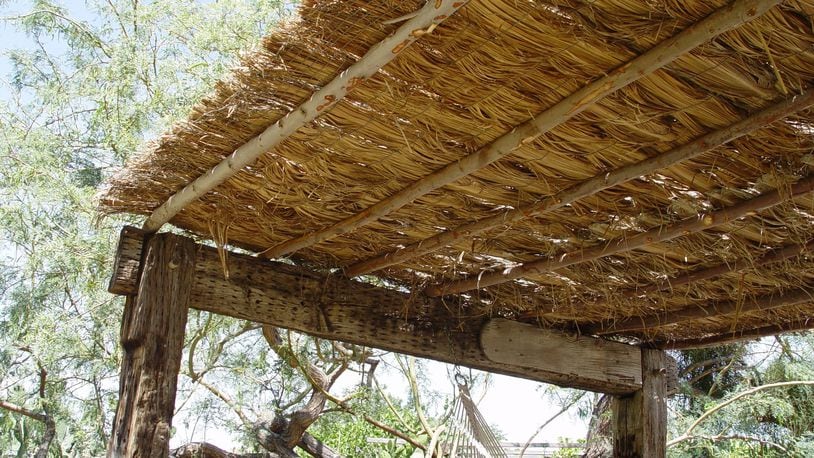These were magical places where big clay water jars hung in the shade beneath. Water seeped through the clay for natural cooling effect due to evaporation.
After the arrival of the Spanish, the brush arbors were renamed “ramada.” It’s a general word for primitive shade structures used to shelter large areas around ranch and mission. There due to irrigation, the ramada became the support for very large grapevines that lived for centuries in these early California sites.
Building a ramada is a great family project after wild weather has left trees damaged from coast to coast. Some trees blow over in high winds, others are ripped to shreds and still more require extensive pruning to repair the damage. This always yields a lot of slash, which are the smaller limbs that result from these clean up operations. This is exceptional material for building your own ramada large or small without spending a penny.
If you must hire a service to remove the tree or its parts, share your plan with the workers. They’ll often help to set aside what you want to save if you can’t be home when the work is done. Otherwise, supervise their work as they go and help select just the right pieces for your future project.
The key is to sort your slash by hand first thing to find the best straightest limbs. Those at least one inch in diameter or larger can become the overhead cross pieces if they are 8 feet or longer. If you have anything about 6 to 10 inches in diameter like a trunk or low branch, select it for your uprights. Anything in between are the supports.
Once you’ve selected the limbs, clean them up with chain saw, loppers or a hand saw. Cut off all the side shoots flush so the limb is smooth. Once all are trimmed, lay them out in a single layer without touching on a well drained concrete slab or asphalt or on a gravel surface to season over the coming months. These surfaces ensure the limbs dry out straight without checks and bends that destroy usability. Above all, avoid contact with earth to prevent rotting. By the time summer rolls around, they may be ready to work with.
You can build your ramada with open cross pieces to support a deciduous vine. As it spreads out across the top, shade beneath increases. After losing its leaves for winter, you can reach it to prune overhead to let the weak sun shine in. Beware that grapes and other woody vines can become heavy over time and will require stronger beams for support. If you try fast-growing summer vines like morning glory or gourds, or frilly clematis, the weight is considerably less.
Native Americans used cordage or rawhide to lash their ramada posts to the overhead cross pieces. Try long wood screws and an electric screwdriver to create strong connections quickly. If the wood is exceptionally old, hard or dry, try predrilling holes before drive screwing to prevent longitudinal cracks in the smaller diameter pieces.
When live gives you lemons, make lemonade. Years of storm damage are a great opportunity to make pruning waste the genesis of your summer project. It’s nothing new, and it’s perfectly natural to use what nature gives you to make something beautiful. Create your ramada for next to nothing, just as every tribe in America did for millennia.
———
Maureen Gilmer is an author, horticulturist and landscape designer. Learn more at www.MoPlants.com
About the Author
